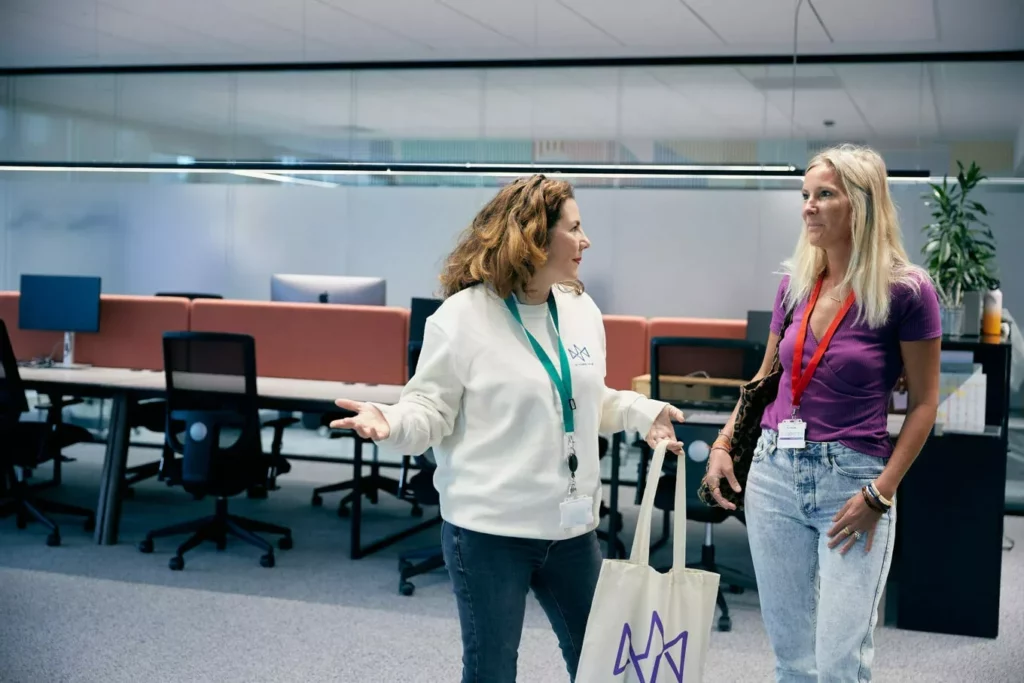If you’re looking for a job, you’re probably hearing more and more aboutonboarding. Companies’ difficulty in hiring has led them to realize the importance of hiring and retaining their employees, right from the recruitment stage, in order to give teams stability. So, with onboarding, turnover is a thing of the past? We’ll explain what onboarding is and how, at Le Connecteur, we’ve designed and implemented a whole process, not forgetting outboarding.
Why pay attention to employee onboarding?
By paying close attention to the onboarding of your employees, you’re simply doing your company a favor. Recruitment and integration processes that better achieve their objectives, stronger and longer-lasting employee commitment, greater loyalty to the company (and therefore reduced turnover), well-being at work for employees, stability for the company. The arguments in favor of this virtuous circle are numerous.
Onboarding: definition
The term onboarding refers to the process a company puts in place to welcome and integrate a new team member as effectively and intelligently as possible. HR and management think and implement a process linked to both :
- welcome (in the sense of taking an interest in and considering the person),
- integration (by all practical means and at all levels – work environment, colleagues, management)
- monitoring employees during their first few months with the company.
Why is this important?
“89% of candidates decide to stay with their company within their first 6 months.” The answer is clear: onboarding is important for company stability. In fact, the lack of thought given to onboarding is glaring. It’s as if, once past the recruitment stage, the “desire” to recruit the employee vanished as soon as the hiring need was met. This in turn leads to under-prepared team integrations that are not always successful. In a domino effect, the consequences for the company can then accumulate, both managerial and financial:
- lack of commitment on the part of the new employee, resulting in a loss of efficiency and productivity for the company,
- This sometimes leads to departures in the first few months, which in turn means additional expenditure and energy for new recruitment,
- teams disrupted by the arrival/departure phenomenon in a short space of time,
- quality of work and life in the company affected, turnover, poor internal and external image of the company, etc.
Optimization and stability
As you can see, it’s worth taking a closer look at this approach to onboarding, which, far from being a trend, is designed to genuinely improve employee integration. And the company can only win! The main virtue is the stability that every company seeks for its development and long-term future. But there are also :
- long-term employee commitment and loyalty,
- optimization of the recruitment and integration process (time, energy, budget),
- greater consistency in the integration process between employees,
- virtues in terms ofcorporate image, a stronger sense ofbelonging and well-being at work.
Onboarding “made by Le Connecteur
“It’s all about the human touch, the human warmth, so that the person feels welcomed, considered and therefore integrated.” Laure Barucq, Customer Experience and Coworking Manager
At Le Connecteur, we’ve thought carefully about onboarding and outboarding both our coworking space members and our in-house staff. The aim is always to echo one of our pillars: making things easier. We share our best practices with you, and hope they inspire you!
Onboarding: our advice
In our experience, there are a few key steps to well thought-out onboarding:
- A good onboarding is one that is prepared in advance of the person’s arrival.
- The first contact is essential: the first day helps to “set the tone” as soon as the employee arrives, for an optimal first impression.
- Practical aspects are important: it’s important to pay attention to detail when welcoming a new employee. Think about all the practical details that will ensure a quick and efficient arrival.
- Show interest and availability to the person, despite the rush in the schedule.
- The post-start-up briefing a few weeks later: a feedback session is essential to take stock in the short term of the person’s start in the company; it’s an opportunity for additional information or readjustments that are often very useful.
Onboarding members and teams

We have designed the onboarding of our coworking members to be very similar to that of our in-house team. Because customers and employees alike deserve to be treated in the same way. Whether you’re joining an entrepreneurial community or a corporate team, attention to detail makes all the difference in building loyalty and turning people into true ambassadors of the Le Connecteur brand.
- First-day care: feeling expected is a good start, when you know that first impressions are crucial!
- a personal welcome kit (badge, goodies, welcome booklet…) and personalized attention,
- the dedicated workstation with a personalized message and the accesses ready for the big day,
- answer the practical questions that arise in an employee’s day-to-day work (lunch breaks, working hours, etc.),
- be available to take the time to welcome the person;
- Being close to people and listening to them: because it’s important that they don’t feel alone, but supported in the integration process.
- visit and presentation of the site and teams,
- make sure the person is not alone for their first breakfast,
- get to know and understand the person’s specific needs to help them adapt,
- the bonus? a sponsor to act as a mentor and provide ongoing support.
- Support and review after 1 month: beyond the busy day of arrival, it’s essential to maintain the link and build on it over the weeks.
- weekly update to anticipate any sticking points,
- encourage people to reach out to others and introduce themselves, if necessary by making connections,
- accept that onboarding requires a certain amount of time, and support the person until he or she is fully integrated.
Did you know? At Le Connecteur, a team is dedicated to “theIn addition, an internal application and a slack system are used to circulate information and federate groups. In addition, an internal application and a slack system are used to circulate information and federate groups.
Outboarding (or offboarding): why is it so important?
While welcoming a new employee in the best possible way seems to make perfect sense, the same cannot always be said of outboarding, which is even more neglected by companies. And yet! There are several very practical reasons to take care of your employees’ departures:
- Feedback: improve the employee experience of your onboardings by taking the time for an end-of-contract exchange, why not a questionnaire to understand the positive and negative points, with a view to optimizing future recruitments.
- Turn your departures into ambassadors: if the end of the contract is a good one, it’s worth talking to the person who can become a kind of brand ambassador (on LinkedIn, for example), talking positively about their experience with the company. In this way, you can even imagine creating a sort of “alumni” community, proud to have belonged to your company and saying so.
- End on a high note: just as it’s essential to make a good first impression, it’s equally important to take care of an employee’s departure, and therefore their last image of the company (from the famous farewell party to a personalized message thanking them for the work they’ve done). It’s an opportunity to express your gratitude, an essential feedback to help everyone close this chapter.
“At Le Connecteur, we always proceed in the same way: a check-up for the practical aspects (return of equipment, badge, invoicing) and a time to discuss the employee’s feedback and understand the reasons for his or her departure, so that we can learn from it and always improve. It’s always very rewarding. And it’s a great way of saying thank you and saying goodbye. Laure Barucq
Have you thought of any other original onboarding ideas? Be creative for your company and share your best tips on our social networks!
